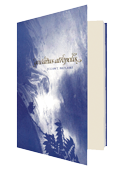It is said that what was remarkable in Willem de Kooning’s paintings wasn’t the rendering of an image but the way de Kooning moved the paint according to how he felt it should move. Punk country poet Julian T. Brolaski’s gowanus atropolis does not so much explore as gather thoughts—on politics, place, people, and sex—and the way Brolaski chooses to render them is, similarly, by moving the words and symbols into a unique amalgam. Brolaski’s innovation with the paint, as it were—the word choice, the syntax, the invention of words and of terms—recycles the ash of the already-been landscape into something beautiful.
This innovation takes shape around Brolaski’s keen ability to couch relevant issues in generalized approaches to a culture of thought democracy: relevant issues such as war and despair in a modern Western construct, love and despair in a modern Western construct, money and despair in a modern Western construct. Brolaski introduces political dialogue while usurping its causes as metaphors for the individual—when bringing up topics like war or money, the poet creates new ways to reveal the self. Brolaski’s entry points are unexpected, our subject matter the individual and the collective at once. Peeling away the paint of the zeitgeist, though, we also find a greater sense of a longing for sense—sense which, here, is arrived at through triumphant discussions of masculinity. “Wimp become hunk,” Brolaski writes, simply and genderlessly balancing on a canyon-crossing suspension bridge: “discovered a name’s / an elastic thing / one writes not so much about / as around homosexual desire.”
Brolaski’s talent for self-awareness, even in those moments when the poet is most vulnerable, offers a lovely reflection of the times in which we reside—where so much of communication exists electronically, and so much entertainment the same. Brolaski is part of the movement to bring internet linguistics and pop-culture allusion further into the modern poetic canon; those crucially concerned with language will note gowanus atropolis‘s loud and unapologetic re-twixting of letters—she and he become xe repeatedly, not so much bending gender as holding it above one’s head and blurring it in sunlight—as well as the extensive pop reference base it deploys. Brolaski moves from Chaucerian wordsmithing to hip-hop cloning to #webtalk; the aggregate #works for xim.
Gowanus atropolis moves us from common issues toward an account not only of the collective thought-state of the country but also of a push to create art with a new craft that is ethereal, intuitive, intellectual, unboring. Double entendres, double wording, double whammies: “you’re ruining like, our whole day / whining for an exbox.”
Brolaski melts images together and melts gender marks together, nodding to earlier art and making it new. People become fish; politics are apparent. Mythological references abound: stars, crab claws, fates singing up from under fountain water, tossed like glitter dust in soft wind, chiming yet fleeting, flecks finding places to stick, to make a world more beautiful. Ever so subtly, we find humor within the dramatics, in both language and content. Brolaski flutters eyelashes and hollers slang colloquialisms. Gowanus atropolis dismantles extremes between the self and the collective while inventing its own language, signifying to the larger eye that the linguistic canon as previously accepted is en route to being turned in on its own shape-shifting self.
—Nicolle Elizabeth
Publisher: Ugly Duckling Presse; Unifying vehicle of meditation: the Gowanus Canal in Brooklyn; Poet’s preferred pronouns in English: xe, sie, ze, zie, e, ey, they; Poet’s explanation of book’s preferred subject pronoun: “xe is my enemigma / & shall endure all privilege”; Potential epigraph from Willem de Kooning: “Maybe in that earlier phase I was painting the woman in me. Art isn’t a wholly masculine occupation, you know”; Second potential epigraph from Willem de Kooning: “I think I’m painting a picture of two women but it may turn out to be a landscape.”





